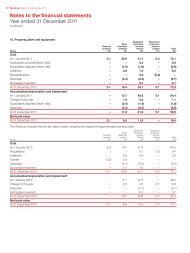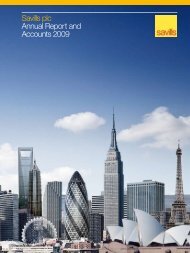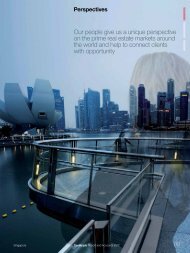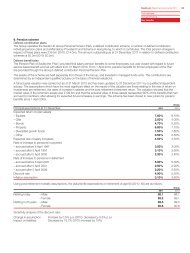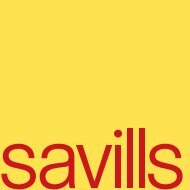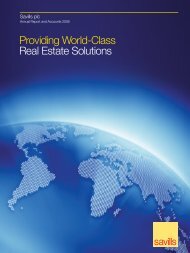Savills plc 2012 Annual Report - (PDF) - Investor relations
Savills plc 2012 Annual Report - (PDF) - Investor relations
Savills plc 2012 Annual Report - (PDF) - Investor relations
Create successful ePaper yourself
Turn your PDF publications into a flip-book with our unique Google optimized e-Paper software.
Notes to the financial statementsYear ended 31 December <strong>2012</strong>continuedWhen a foreign operation is sold, exchange differences that wererecorded in equity are recognised in the income statement as partof the gain or loss on sale. Goodwill and fair value adjustmentsarising on the acquisition of a foreign entity are treated as assetsand liabilities of the foreign entity and translated at the closing rate.Property, plant and equipmentProperty, plant and equipment is stated at historical cost lessaccumulated depreciation and impairment. Historical costincludes expenditure directly attributable to acquisition.Subsequent costs are included in the asset’s carrying amount orrecognised as a separate asset, as appropriate, only when it isprobable that the future economic benefits associated with theitem will flow to the Group and the cost of the item can bemeasured reliably.Provision for depreciation is made at rates calculated on a straightlinebasis to write off the assets over their estimated useful livesas follows:Freehold propertyLeasehold property (less than 50 years)Furniture and office equipmentMotor vehiclesComputer equipment50 yearsover unexpiredterm of lease3 – 6 years3 – 5 years3 – 5 yearsUseful lives are reviewed and adjusted if appropriate, at eachreporting date.An asset’s carrying amount is written down immediately to itsrecoverable amount if the asset’s carrying amount is greater thanits estimated recoverable amount.GoodwillGoodwill represents the excess of the cost of acquisition of asubsidiary or associate over the Group’s share of the fair valueof identifiable net assets acquired.In respect of associates, goodwill is included in the carrying valueof the investment.Goodwill is carried at cost less accumulated impairment losses.Separately recognised goodwill is tested annually for impairment,or more frequently if events or changes in circumstances indicatepotential impairment. Impairment losses on goodwill are notreversed. Gains and losses on the disposal of an entity includethe carrying amount of goodwill relating to the entity sold.Goodwill is allocated to cash-generating units for the purposeof impairment testing. The allocation is made to those cashgeneratingunits or groups of cash-generating units that areexpected to benefit from the business combination in which thegoodwill arose. The Group allocates goodwill to each businesssegment in the geographical region in which it operates (Note 14).Intangible assets other than goodwillIntangible assets acquired as part of business combinations andincremental contract costs are valued at fair value on acquisition andamortised over the useful life. Fair value on acquisition is determinedby third-party valuation where the acquisition is significant.Acquired computer software licences are capitalised on the basisof the costs incurred to acquire and bring to use the specificsoftware. Costs associated with maintaining computer softwareprograms are recognised as an expense as incurred.Development costs that are directly attributable to the design andtesting of identifiable and unique software products controlled bythe Group are recognised as intangible assets when the followingcriteria are met:– it is technically feasible to complete the software product sothat it will be available for use;– management intends to complete the software product anduse or sell it;– there is an ability to use or sell the software product;– it can be demonstrated how the software product willgenerate probable future economic benefits;– adequate technical, financial and other resources to completethe development and to use or sell the software product areavailable; and– the expenditure attributable to the software product during itsdevelopment can be reliably measured.Measurement subsequent to initial recognition is at cost lessaccumulated amortisation and impairment.Intangible assets are tested for impairment where there is anindication that an asset may be impaired. An impairment loss isrecognised to the extent that the carrying value exceeds thehigher of the asset’s fair value less cost to sell and its value-in-use.Amortisation charges are spread on a straight-line basis over theperiod of the assets’ estimated useful lives as follows:Computer softwareProperty management contractsIncremental contract costsBusiness and customer <strong>relations</strong>hipsBrands3 – 5 years2 – 10 years10 years6 – 10 years5 yearsImpairment of other non-financial assetsAssets that have indefinite useful lives are not subject toamortisation and are tested annually for impairment. Assetsthat are subject to amortisation are reviewed for impairmentwhenever an indicator of impairment exists. An impairment lossis recognised to the extent that the carrying value exceeds thehigher of the asset’s fair value less cost to sell and its value-in-use.Value-in-use is determined using the discounted cash flowmethod, with an appropriate discount rate to reflect market ratesand specific risks associated with the asset.For the purposes of assessing impairment, assets are groupedat the lowest levels for which there are separately identifiablecash flows (cash-generating units). Where it is not possible toestimate the recoverable amount of an individual asset, the Groupestimates the recoverable amount of the cash-generating unit towhich the asset belongs.Financial instrumentsFinancial assets and liabilities are recognised on the Group’sstatement of financial position at fair value when the Groupbecomes party to the contractual provisions of the instrument.Subsequent measurement depends on the classification and isdiscussed in the following paragraphs.68 <strong>Savills</strong> <strong>plc</strong> <strong>Report</strong> and Accounts <strong>2012</strong>






